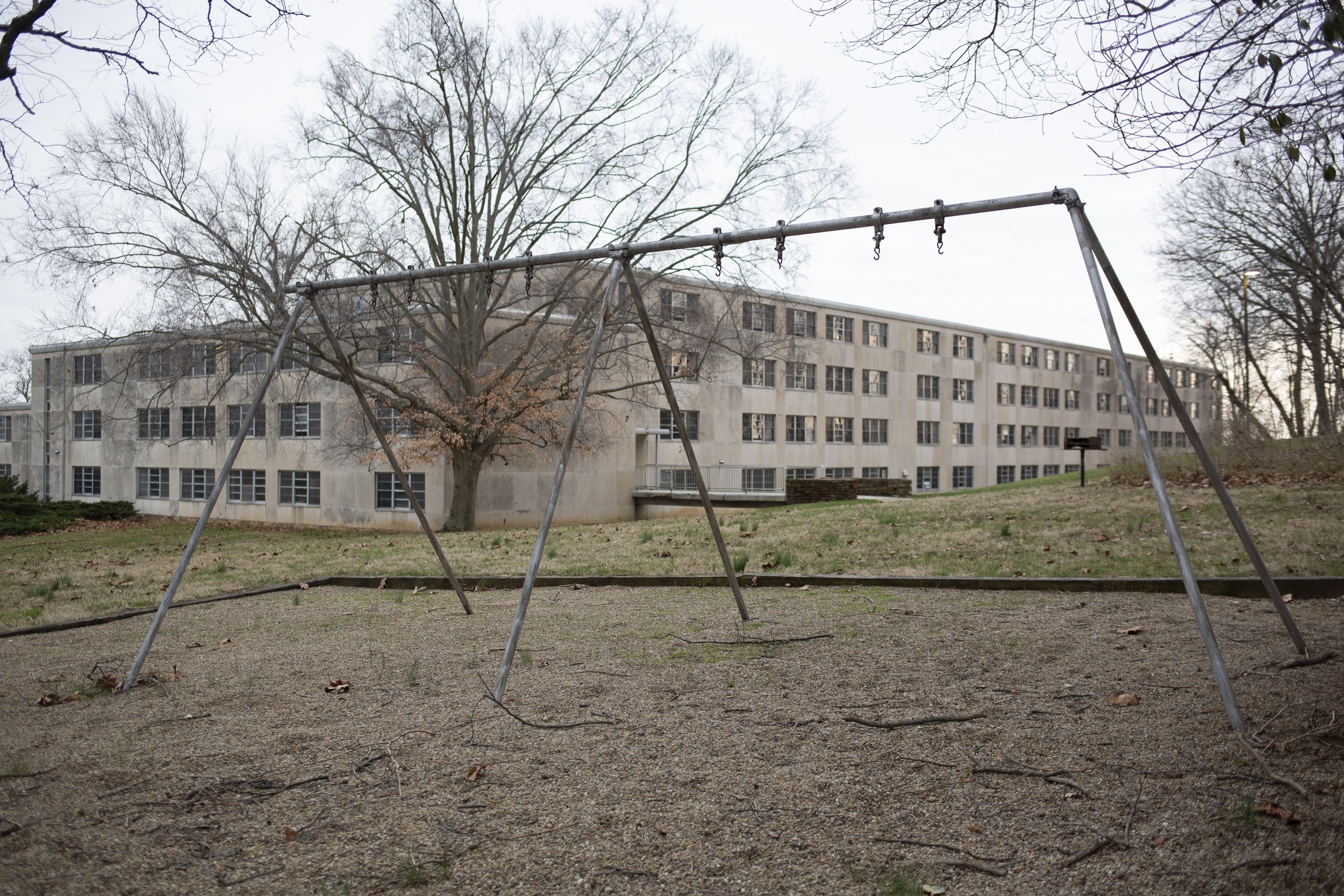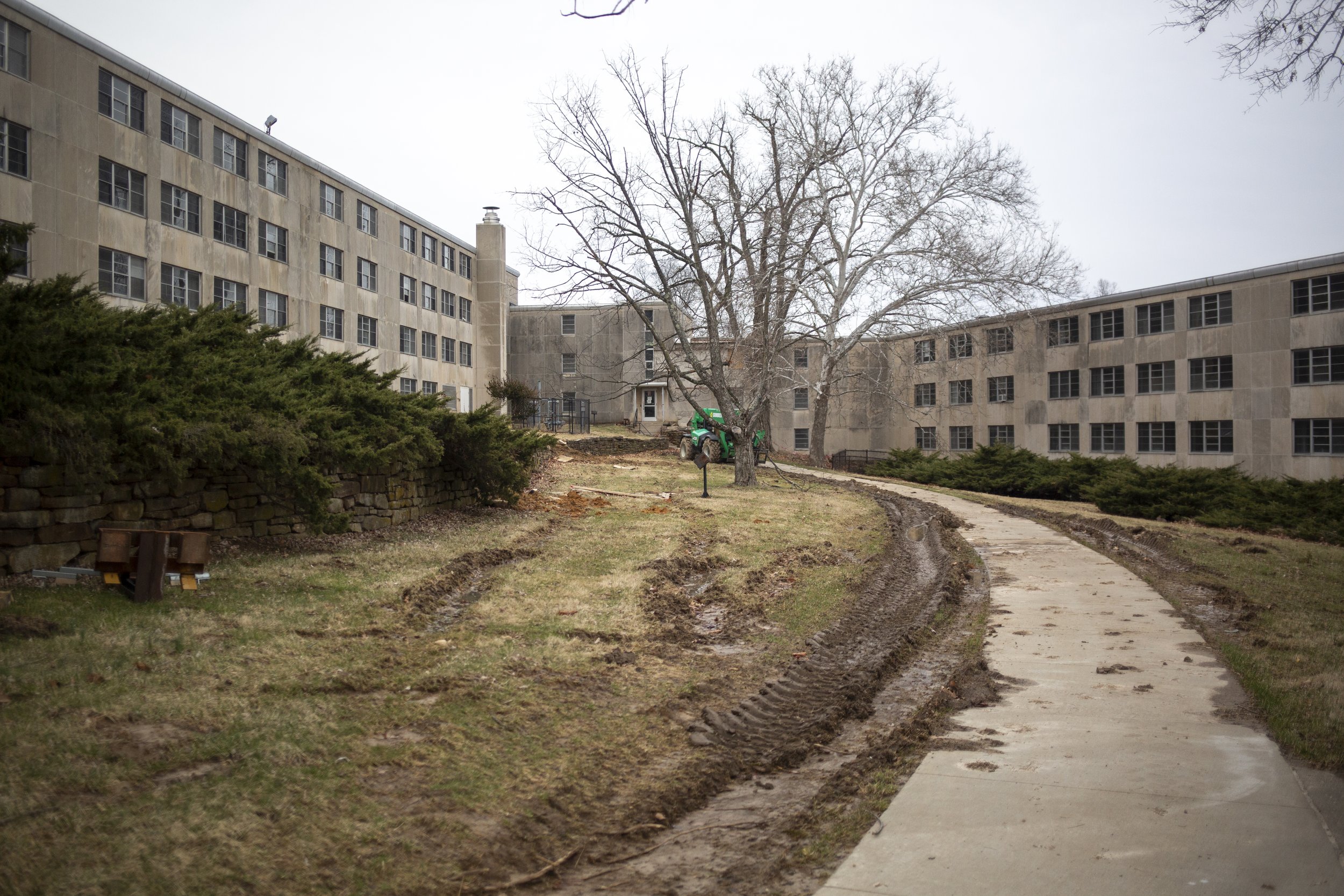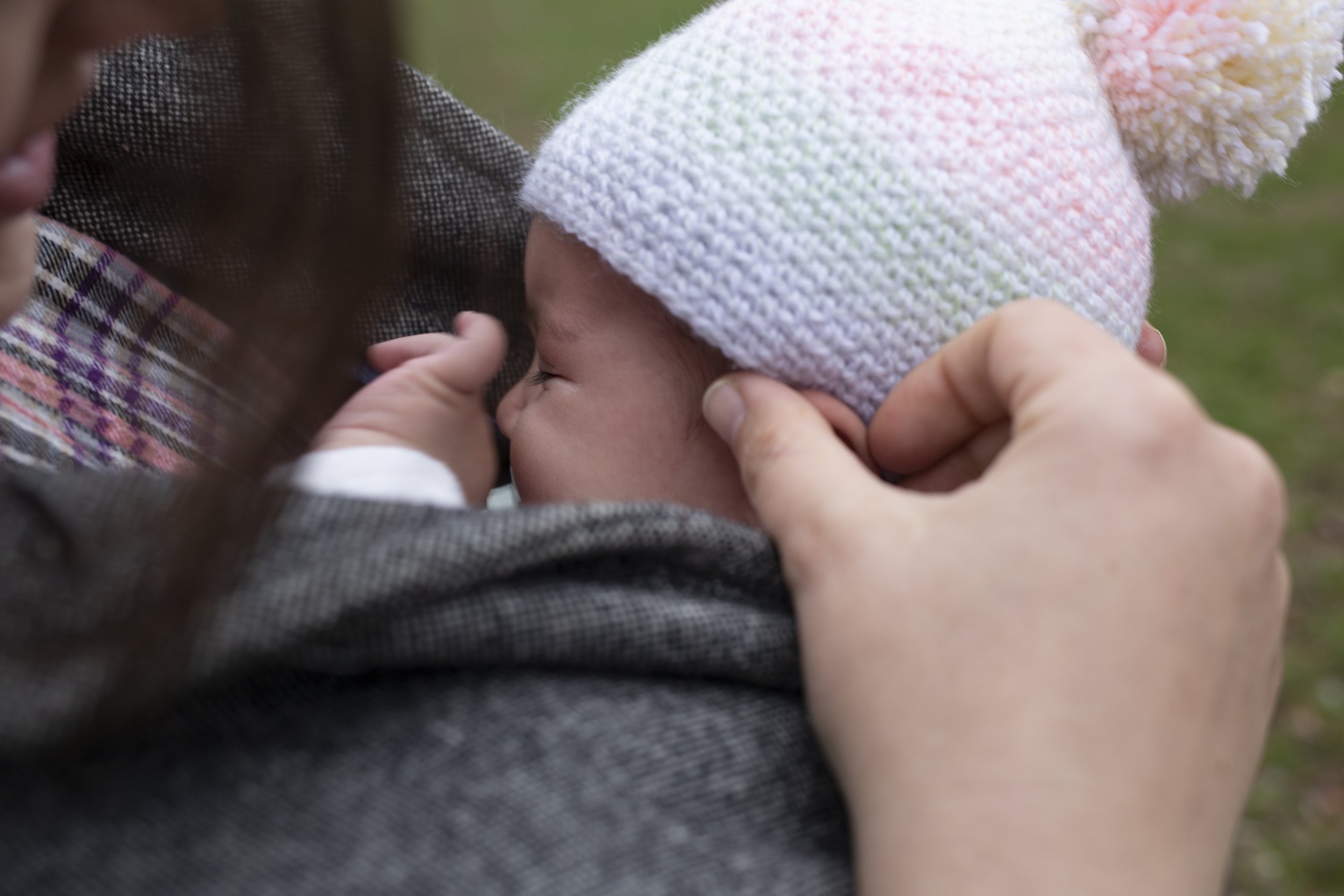There goes the neighborhood: Redbud Hill residents face demolition
Nada ElGhazaly, her husband Ihab Mohamed and their seven-year-old daughter Arwa pose for a family portrait in their Redbud Hill apartment on April 9, 2022. The apartment building they live in, which is home to a number of international graduate students and their families, will be demolished.
Originally from Egypt, Ihab Mohamed’s research in robotics had taken him to Poland, Italy and France before he and his family landed at IU’s Redbud Hill apartments last year.
Some experiences have been better than others. Ihab left France just six months short of earning a doctorate because of the difficult relationship with his advisor and the lack of respect he says his family faced as immigrants from Egypt.
But at IU, where he is pursuing his doctorate, and the campus’ Redbud Hill apartments, Mohamed and his family have found a welcoming community.
The children — seven-year old Arwa and her nine-year-old brother Anas — were the first to make friends, but it didn’t take long before their parents were sharing meals with their neighbors in the grassy space in front of their building.
Mohamed tried seafood, prepared by a Korean neighbor, for the first time at a picnic table by the mailboxes.
Unlike in France, where Mohamed’s wife, Nada ElGhazaly, was discriminated against for wearing a hijab, Mohamad says he feels at home there in the month of Ramadan. Members of their mosque, including some neighbors, take turns preparing the iftar, or evening meal.
“As a Muslim here, there is much care,” Mohamed said. “It’s a good community.”
But inside the family’s apartment, boxes are packed and waiting for their upcoming move.
Mohamed’s is one of the last leases honored by Redbud Hill apartments. The buildings, completed in 1960, will be demolished along with the rest of the neighborhood.
Demolition is underway on Evermann Apartments April 19, 2022. The buildings were completed in 1957 to acomodate an influx of married students taking advantage of the G.I. Bill after the Korean War.
With the demolition, IU is losing more than a cluster of mid-century apartment buildings on the outskirts of campus. They’re losing a neighborhood where children find games to play across language barriers while their parents share food and friendships and where decades’ worth of international graduate students, supported by this community and campus living resources, have learned to navigate life in a new country.
But IU can no longer support the aging buildings, and the pandemic has complicated the path to replacing them.
Across the country, renters and housing providers are facing similar struggles as the affordable housing shortage intensifies nationwide.
“We’re very proud of what these buildings have been able to do,” Tim Stockton, the director for administration at Residential Programs and Services, said.
But, he said, it’s time to say goodbye to the buildings that have “served with honor” for more than 60 years.
“When a building gets to a certain age, it’s just not the right thing to do to keep people in it,” Stockton said.
Adjacent to Redbud Hill, Bicknell and Hepburn apartments, completed in 1955, were leveled in 2020. Their sister buildings, Banta and Nutt apartments, sit vacant and waiting to be razed.
Demolition on Evermann apartments, completed in 1957, began in April. Mohamed could see the building go down from his living room window.
Formerly known as married student housing, the neighborhood in the northeast of campus once had more than 400 apartments. Redbud Hill, the only buildings that remained open this year, consists of 120 2-bedroom apartments.
Many of them are home to international graduate students, like Mohamed, who live with their families. Next year, the tenants will have to find other places to live.
“Destroying this place actually makes— ” Mohamed said, pausing.
“A lot of people suffer,” ElGhazaly said, finishing her husband’s sentence.
“Especially the ones who have families,” Mohamed continued.
An abandoned swing set in front of Evermann apartments, pictured March 29, 2022. Demolition started on the apartments on April 18, 2022.
Tom Morrison, IU’s vice president for Capital Planning and Facilities, says the struggle to find affordable housing in Bloomington is widespread.
"That is a question that is pervasive in this community. Period. And it's not just related to, say, graduate students, or married students, or students with families,” he said.
Nor is the problem unique to Bloomington. A market analysis from the national real estate brokerage Redfin found the price of rent in January was up 15 percent nationwide over the last year.
Forbes reports the affordable housing crisis is driven by a shortage in housing supply. The Federal Home Loan Mortgage Corporation estimated that in the fourth quarter of 2020, the U.S. was short about 3.8 million units, up more than 50percent from 2.5 million units in 2018.
While the shortfall has been steadily growing for years, the pandemic has exacerbated it.
The cost of building has risen dramatically since the pandemic began, thanks to high prices of construction materials, soaring inflation and ongoing disruption to supply chains, among other issues. The high cost of building further stresses the ability of developers — or universities — to offer housing at a low price.
How the university plans to offer more affordable housing options going forward is “the golden question,” said Residential Programs and Services executive director Luke Leftwich.
Responding to the COVID-19 pandemic has been complicated for university housing units like RPS, he said, and has dramatically raised the cost of doing business.
Leaving more beds open in dorms, stepping up cleaning and providing personal protective equipment to staff, installing plexiglass barriers and offering to-go options for dining halls — all while navigating labor shortages and supply chain issues — has been costly.
Leftwich worries about how RPS can continue to provide necessary services without passing on the extra cost to students.
“I think it's going to be the biggest challenge for housing units throughout the country for the next three to five years,” he said.
Abdul Aijaz and Gwen Kirk, holding her four-month-old daughter Zohra, prepare for a picnic on April 23, 2022. The kitchen in their Redbud Hill apartment is small, so the cooking efforts expand into the living room.
In the building next to Mohamed’s, Abdul Aijaz, a Ph.D. candidate in geography and English literature, shares an apartment with his wife, Gwen Kirk, and their 5-month-old daughter Zohra.
Aijaz first moved into the neighborhood from Pakistan in 2014, when a Fulbright scholarship sent him to IU.
Kirk joined him at Redbud Hill the following year. The couple lived briefly in Bicknell before moving to an apartment in the Banta building that they both loved for its mid-century charm and clever storage.
Now, the couple is back in Redbud with a new mouth to feed.
Abdul Aijaz holds his three-and-a-half-month-old daughter Zohra in his Redbud Hill apartment on March 29, 2022. Aijaz has lived in three of the buildings in the northeast neighborhood since he first moved there from Pakistan in 2014. One has already been leveled, one is vacant and waiting to be razed and his current building is slated for demolition.
Aijaz says he made around $17,000 this year before taxes and fees. The family’s income is supplemented by Kirk’s salary as a lecturer in Pakistan. She’s currently on maternity leave. But her pay, calibrated for the lower cost of living in Pakistan, is modest by American standards.
International graduate students often face a unique challenge of trying to find affordable housing on stipends they can’t supplement with outside work without jeopardizing their Visas.
At $698 a month for two bedrooms with utilities included and dedicated bus service, Aijaz says there isn’t a better deal out there for international graduate students in Bloomington.
IU has no immediate plans for how to replace the two-bedroom apartments lost in the neighborhood’s demolition with other units at a comparable price point, but the clock has run out on the buildings’ infrastructure.
Leftwich explained that after more than 60 years of continuous occupation, the buildings in the northeast neighborhood needed significant attention to keep them within IU’s standards for a safe living environment.
And if IU were to invest in any renovations, he said, then they would be legally required to bring the buildings up to current standards — such as accessibility requirements for residents with disabilities or updated ventilation systems to improve air quality — that the buildings’ architecture was not designed to accommodate.
While Redbud Hill apartments are no longer able to support the stress of being fully occupied, Morrison said, they will not be immediately demolished. Rather, they’ll enter what he called “suspended animation.”
Evermann Apartments, completed in 1957, sit vacant on March 8, 2022. Demolition began on the building April 18, 2022.
Morrison explained that next year, RPS is planning to set the apartments aside as quarantine and isolation housing in the event of another wave of COVID-19, while the Ashton Center will be returned to regular service.
The 2010 Master Plan for the Bloomington Campus explains that the buildings’ eventual demolition will make way for more open space.
Plans for the area include a recreation and sports park anchored around an expansion of the existing Student Recreational Sports Center, a restoration of the Campus River headwaters and an enhancement of the Hilltop Garden and Nature Center.
In 2020, the master plan was updated. The most recent version of the document designates the area adjacent to Tulip Tree Apartments, along what would be the edge of the new green space, as a potential site for new apartment style housing.
Discussions about how to replace the aging apartments in the northeast neighborhood were underway before the pandemic, Morrison said, but had to be put on hold while IU officials focused on the response.
Now the university will have to factor in changes to the economy over the past few years, Bloomington’s new housing options, uncertain enrollment and demand for on-campus apartments after the pandemic.
On top of that, new leadership at IU — including a new provost, president and chief financial officer — will all need to be a part of the decision-making process. The new administrators, said Morrison, are assembling teams to begin the process of assessing the viability of building new student apartments.
If the assessment began today, Morrison said, it could be five years before the first student moves in. That is, if the university decides to build.
“Apart from the individual person who may be looking for an apartment,” he said, “it's not a bad thing that we're doing this in a very purposeful way, to make sure that we're making right decisions.”
When Aijaz and Kirk came back this fall from two years spent in Pakistan, where Aijaz conducted his research, Bicknell was gone. The couple crossed the grass that grew in its place to see the empty shell of their old apartment in Banta.
Nothing remains of their life there but the curtain Kirk once tied in a knot to let the morning light in. There’s a square stain on the patio in front of the apartment where their planter used to sit. Kirk still sometimes picks mint from their neighbor’s abandoned garden.
“It feels very desolate,almost like haunted,” Kirk said”
Gwen Kirk picks daffodils to brighten her apartment from an abandoned garden patch outside Banta Apartments March 31, 2022. "It's been so gray," she said. Kirk used to live in the apartments, which now sit empty awaiting for demolition.
Aijaz has heard a lot of rumors about the future of the buildings he’s called home, but nothing from the administration itself beyond their closing date.
RPS notified Redbud residents at the beginning of this lease year that the buildings would close at the end of July, in order to give them time to find new housing. They’ve also tried to ease the transition by giving current residents priority in other campus apartments, letting them out of leases early if they find other housing and offering places for them to store their belongings over the summer.
But the plans for the buildings and the land under them are largely out of RPS’s hands, Tim Stockton said.
Aijaz says the lack of communication about why the apartments are closing is disrespectful and exacerbates a feeling of alienation many international students feel living in a foreign country.
Living among abandoned buildings in apartments whose days are numbered, he said, compounds that feeling.
“It’s double alienating,” he said.
Gwen Kirk checks on her daughter Zohra, tucked into her jacket against the cool weather for a walk on March 31, 2022. Kirk stands in the grassy field where Bicknell apartments, where she lived in 2016, used to stand before their demolition in 2020.
Aijaz and Kirk are making their plans for next year. They are weighing moving with their young daughter back to Pakistan, where both of them could find work as professors, or staying in the U.S., where they would face a tough job and housing market.
Kirk, currently an anthropology professor, is considering changing fields in search of something with more financial security.
Mohamed and his family will move to College Mall Apartments this summer, but said other families in Redbud Hills had a hard time finding housing for the next year.
Some neighbors decided to stay on campus. But at $1,219 a month, Mohamed says the cheapest two-bedroom apartment at IU would leave him with only around $500 left over from his monthly income to cover the family’s costs.
At College Mall, Mohamed expects to pay around $900 a month, but he’s worried about his kids having to change schools. They’ve made friends at University Elementary School — just a short bus ride from Redbud Hill — and after so many moves, he doesn’t want to disrupt them again.
Mohamed and his family had hoped to take the community they had built with them, organizing their neighbors to move to College Mall Apartments as well.
“It was a dream,” he said.
But by the time other families started applying, just a week after they signed their lease back in October, he said, there was already a waiting list for next August.
The picnic table in front of Redbud Hill apartments, pictured on March 29, 2022, where Ihab Mohamed tried seafood for the first time. On the wall behind it, among chalked writing in different languages, you can read his daughter's name: Arwa.










